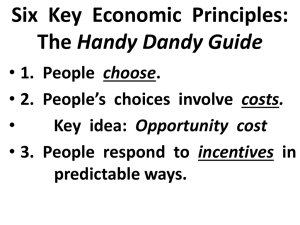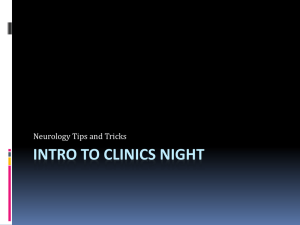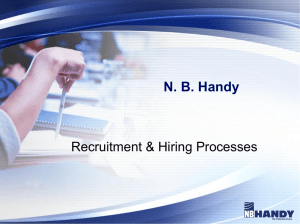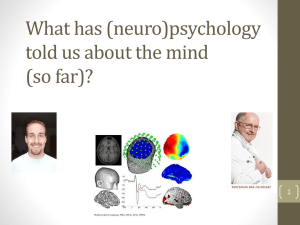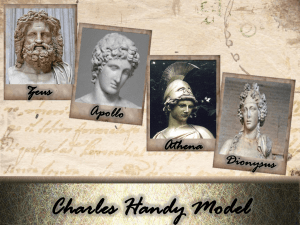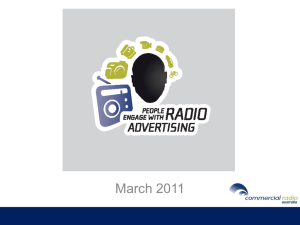Neurological Examination
advertisement
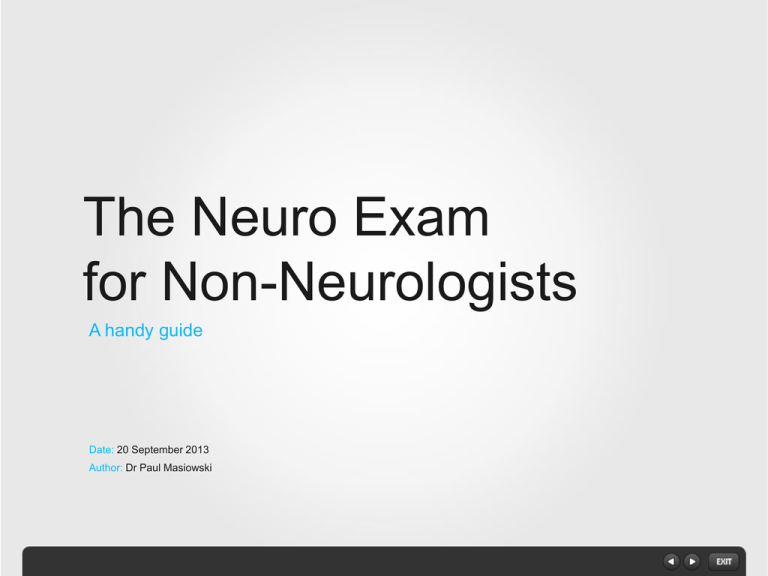
The Neuro Exam for Non-Neurologists A handy guide Date: 20 September 2013 Author: Dr Paul Masiowski The Neuro Exam for Non-Neurologists A handy guide Objectives The neurological examination This handy guide will help you review and develop your neuro exam skills! We will: •Review the full neuro exam in overview •Study the “Saskatoon Screening Exam” (a 5 minute neuro exam sufficient to make most diagnoses) •Study a faster screening exam (a 2 minute neuro exam sensitive enough to rule out serious pathology in most patients) •Discuss tips and tricks for improving the sensitivity and reliability of the exam •Consider how and when to expand the screening exam screening for: •dementia, headache, parkinsonism, tremor, myasthenia, myelopathy, neuropathy, etc. All that in 40 minutes (give or take)! The Neuro Exam for Non-Neurologists A handy guide Biography and disclosures •Queen’s Medicine, 2005 •USask Neurology residency, 2005-10 •FRCPC (Neurology) 2010 •Community practice at Lakeview Neurology Associates •Clinical Assistant Professor at USask •SMA Section Rep •Received honoraria from Allergan •Interests: Migraine, Neuropsychiatry, Movement Disorders The Neuro Exam for Non-Neurologists A handy guide The neurological examination is a diagnostic test One that tells you where the problem is Like all tests, you need it to be reliable. • Find important abnormalities • Recognize when something unusual is actually normal You need to know what the implications are of normal or abnormal results The Neuro Exam for Non-Neurologists A handy guide Outline of the neurological examination The overview 1.Mental Status 2.Cranial nerves 3.Motor 4.Reflexes 5.Sensory 6.Coordination & Gait The Neuro Exam for Non-Neurologists A handy guide The Saskatoon Screening Exam Reviewed with JURSIs weekly at RUH since 1994 A 5 minute examination of the following: 1.Mental Status 2.Cranial nerves 3.Motor 4.Reflexes 5.Sensory 6.Coordination & Gait This is as much of the neuro exam as you need to know, most of the time The Neuro Exam for Non-Neurologists A handy guide Mental status exam The Saskatoon Screening Exam Assessed during history taking (overall impression) If the patient can give a good history... (well organized and detailed demonstrating normal attention and memory with good language function) ...there’s little to be gained from any further testing The Neuro Exam for Non-Neurologists A handy guide Cranial nerve exam The Saskatoon Screening Exam •Visual fields by confrontation (II) •Pupils (II & III)Eye movements (III, IV & VI) •Facial strength (VII)Speech clarity (IX, X, XII) The Neuro Exam for Non-Neurologists A handy guide Motor exam The Saskatoon Screening Exam •Pronator driftStrength in arms and legs (proximal & distal): •Deltoids •Finger extensors •Hip flexors •Tibialis anterior The Neuro Exam for Non-Neurologists A handy guide Reflexes exam The Saskatoon Screening Exam •Brachioradialis, biceps, tricepsKnee jerk, ankle jerkBabinski The Neuro Exam for Non-Neurologists A handy guide Sensory exam The Saskatoon Screening Exam • Lateralizing sensory loss: •pin on both sides, face/arm/leg •vibration on both sides, in toes ... or ... •Distal sensory loss: •pin ascending from toes vibration ascending from toes The Neuro Exam for Non-Neurologists A handy guide Coordination exam The Saskatoon Screening Exam •Finger to nose task •Heel to shin task •Rapid alternating movements •finger tapping •open/close hands •foot tapping The Neuro Exam for Non-Neurologists A handy guide Gait exam The Saskatoon Screening Exam •Normal gait •Tandem gait (not in elderly) •Romberg? (not in elderly) The Neuro Exam for Non-Neurologists A handy guide The 2 minute screening exam So easy, you can do it with any patient 1.Mental status: conversation / history (note speech) 2.Cranial nerves: visual fields, eye movements (look at pupils too), grimace 2a. Fundi (if headache is a concern) 1.Strength: pronator drift, strength in 2 muscles in each limb 2.Reflexes: 2 per limb, Babinski 3.Sensation: skip it (!) 4.Coordination and gait: finger-nose, gait, tandem The Neuro Exam for Non-Neurologists A handy guide Tips and Tricks to improve your exam skills All opinions here are my own Pitfalls to the neuro exam: •Subtle findings •Unexpected findings •Chronic findings •Normally abnormal findings •Findings not due to neurological disease •Patient cooperation (sometimes) Need to have reliable techniques, so you can be confident in the results The Neuro Exam for Non-Neurologists A handy guide Mental status exam •Most historians have normal mental status. Tips good and Tricks •Attention tests should be simple (weekdays or months, backwards) -- avoid math (serial 7s) •Patients who can’t recall 3 words will think for a moment or confabulate or distract; those who say immediately “I can’t remember” have a good prognosis • A quick clock drawing can tell you whether or not to worry The Neuro Exam for Non-Neurologists A handy guide Cranial nerves testing Tips and Tricks Not frequently tested by neurologists: •Smell •Visual acuity •Hearing •Corneal reflex (except in coma) •Gag reflex •Strength in the neck ...unless the situation calls for it The Neuro Exam for Non-Neurologists A handy guide Visual fields testing Tips and Tricks I use “static fingers”, testing by quadrant: •Hold up 1 or 2 fingers in one quadrant •Then on the opposite side •Then test both sides at once (for visual extinction) One eye or two? •Both eyes at once is OK, except in headache patients •Advantage of one-eye-at-a-time is catching pre-chiasmatic lesions (pituitary etc) •Disadvantage is time Wiggling fingers in from periphery is unreliable, test macular (central vision) instead I show fingers for only a second or two, which is all it takes. The Neuro Exam for Non-Neurologists A handy guide Pupils testing Tips and Tricks Observe for symmetry in room light If pupils equal, they’re normal No need for flashlight! Normal variants: •Physiologic anisocoria: pupil asymmetry preserved across spectrum of light/dim •Asymmetric pupil from trauma, surgery, etc Subtle finding: •Horner’s syndrome: miosis usually mild, goes with mild ptosis of upper and lower lids. Pupil asymmetry increases in the dark, so check in the dark The Neuro Exam for Non-Neurologists A handy guide Eye movements testing Tips and Tricks “Follow my finger”... ...all the way to one side, then the other ...then up, down and right at them (convergence) •No need for “H” or other shapes •Observe alignment, don’t ask about diplopia during test Normal variants: •Strabismus, usually congenital (ask). Test each eye separately, movements should be ~normal •Gaze evoked nystagmus: few beats, symmetric at extremes of horizontal gaze. Very common with age, fatigue, mediations (sedatives) The Neuro Exam for Non-Neurologists A handy guide Facial strength testing Tips and Tricks Look for symmetry at rest and spontaneously Grimace: show don’t tell what you want them to do No need to test facial movements one by one Normal variant: •Some asymmetry of the face is normal (except in Hollywood) Ask family if face is different than usual Subtle finding: •Symmetric facial weakness will be missed if you only check for symmetry Look for strength of eye closure (“squeeze them shut”) or lip closure The Neuro Exam for Non-Neurologists A handy guide Speech testing Tips and Tricks Is speech clear? Can almost always decide during conversation If not, test: •Palate elevation (midline?) •Tongue protrusion (midline?) The Neuro Exam for Non-Neurologists A handy guide Pronator drift testing Tips and Tricks Very sensitive test for mild weakness Patient holds hands outstretched forward, palms up and fingers straight Eyes closed, wait 10+ seconds to rule out drift Subtle findings: •Abnormal drift is sometimes down, sometimes turning over (pronating) and sometimes up (“sensory” drift) Normal variant: •Some patients will wave their hands up and down repeatedly and may sway back and forth, even when encouraged to hold still. (I scan them anyway) The Neuro Exam for Non-Neurologists A handy guide Strength testing Tips and Tricks Test muscles likely to be weak with mild deficits (screening test) •Deltoids •Finger extensors •Hip flexors •Ankle dorsiflexors ... are all weaker than their antagonists with an UMN lesion (“corticospinal tract” distribution) Normal variant: •To detect variable effort (“giveway” weakness), make the patient move first, to a target, then against resistance. The Neuro Exam for Non-Neurologists A handy guide Sensory testing Tips and Tricks Test pin and vibration, not light touch, temperature or proprioception •Pin: broken tongue depressor •Vibration: 128 Hz tuning fork (not audible) Ask: •Does this feel sharp? •Do you feel the buzz? •Is it the same on the other side? Slight variations from side to side are OK. •Move from left to right (screening for central problems) •From distal to proximal (screening for neuropathy) •From numb areas to normal areas (ask patient to show you where the transition is) The Neuro Exam for Non-Neurologists A handy guide Coordination testing Tips and Tricks Finger/nose task •Hold target still, no need to move it around •Look for smooth, accurate movements Heel/shin task •Difficult to teach / learn •Limited ROM (arthritis, pain) limits the value of the test Rapid alternating movements: •Finger tapping, open/close fist better than “clap-flip-clap-flip” task, which is difficult Subtle finding: •Mild dysmetria suggests mild weakness Normal variant: •“accurate” missing The Neuro Exam for Non-Neurologists A handy guide Gait testing Tips and Tricks Walk across the room (down the hall) and back. OK to repeat if needed •Width of feet (should nearly touch) •Leg swing •Foot drop •Arm swing Walk on toes / heels (sensitive test of distal strength) Tandem gait: not if elderly Romberg: best done with distraction •I tell them we’re doing a “concentration test” The Neuro Exam for Non-Neurologists A handy guide Additional testing for specific situations Expanding your basic exam to answer harder questions 1.Cerebrum: Does this patient have dementia? Aphasia? 2.Basal ganglia: Is this a Parkinsonian tremor? 3.Brainstem and cranial nerves: Does this patient have a central cause of dizziness? 4.Cerebellum: Does this patient have a central cause of imbalance? 5.Spinal cord: Does this patient have a spinal cord lesion? 6.Motor neuron: Does this patient have ALS? 7.Peripheral nerve: Is this numbness due to neuropathy? 8.Neuromuscular junction: Is this patient fatigued because of myasthenia? 9.Muscle: Is this weakness due to myopathy? The Neuro Exam for Non-Neurologists A handy guide Cerebrum: dementia, aphasia Expanding your basic exam to answer harder questions Mental status quick screen (prefer this to MMSE or MoCA): •orientation •memory -- delayed recall of 3 word list •attention -- months of the year backwards •clock drawing Language testing (simple --> complex): •naming •repetition •comprehension (commands) •fluency (in conversation) The Neuro Exam for Non-Neurologists A handy guide Basal ganglia: tremor, parkinsonism Expanding your basic exam to answer harder questions Tremor: •at rest? (usually in hands) -- worse with distraction •with posture (hands, head) •with activity (finger-nose) Rigidity •at wrist, elbow, knee -- worse with distraction Bradykinesia •finger tapping, open-close fists, foot tapping •masked face, decreased blinking, hypophonic voice Gait •shuffling, decreased arm swing, flexed posture, en bloc turns The Neuro Exam for Non-Neurologists A handy guide Brainstem and cranial nerves: vertigo Expanding your basic exam to answer harder questions Cranial nerves: •Horner’s syndrome •eye movements, nystagmus •dysarthria •facial sensation, symmetry Sensory and Motor: •crossed findings (face on one side, arm/leg on the other) Special test: Head Impulse test Patient focuses eyes on tip of your nose. Gently but suddenly twist head 10-15 degrees to one side, then the other. If eyes remain fixed, normal. If corrective saccade brings them back to midline, vestibular dysfunction. A normal head impulse test in the setting of acute vertigo suggests stroke or other central cause. The Neuro Exam for Non-Neurologists A handy guide Cerebellum: imbalance, clumsiness Expanding your basic exam to answer harder questions Ataxia: •ataxia / dysmetria on finger-nose and/or heel-shin tasks •clumsiness with rapid movements (finger tapping etc) •slurred speech •difficulty walking in tandem Tremor: intention tremor with finger-nose Eye movements: nystagmus (especially up or downbeating) Gait: wide based, unable to walk in tandem NB: Romberg is not a “cerebellar” test, it’s a test of proprioception The Neuro Exam for Non-Neurologists A handy guide Spinal cord: myelopathy Expanding your basic exam to answer harder questions xxx: •ataxia / dysmetria on finger-nose and/or heel-shin tasks •clumsiness with rapid movements (finger tapping etc) •slurred speech •difficulty walking in tandem Tremor: intention tremor with finger-nose Eye movements: nystagmus (especially up or downbeating) Gait: wide based, unable to walk in tandem NB: Romberg is not a reliable “cerebellar” test The Neuro Exam for Non-Neurologists A handy guide Motor neurons: ALS Expanding your basic exam to answer harder questions Strength testing: •expect “corticospinal” pattern of weakness •may be only in 1-2 limbs early in disease Muscle atrophy Fasciculations •Look in larger muscles (calves, quads, triceps, deltoids, pecs) •Patient may be able to direct you Reflexes: expect an “upper motor neuron” sign (hyperreflexic, Babinski) No sensory symptoms or signs The Neuro Exam for Non-Neurologists A handy guide Peripheral nerve: Neuropathy Expanding your basic exam to answer harder questions Sensory loss / painful dysesthesiae •in distribution of a single nerve (branch) •in distribution of a single root •distal symmetric (stocking-glove) Weakness / atrophy •in distribution of a single nerve (branch) •in distribution of a single root •distal symmetric (stocking-glove) Requires enough neuroanatomy to be satisfied that other nerves/roots are OK ...complex pictures can be hard to sort out (even for specialists)cover_image.asp The Neuro Exam for Non-Neurologists A handy guide Neuromuscular junction: myasthenia Expanding your basic exam to answer harder questions “PD 3”: •ptosis (usually asymmetric, variable) •diplopia / eye movement abnormalities (esp upgaze) •dysarthria (nasal speech) •dysphagia (to liquids, on history) May also have: •facial weakness (symmetric) •neck weakness (check flexors) •limb weakness (proximal > distal, usually symmetric) Test fatigability: •prolonged upgaze (ptosis, upgaze) •dysphagia (to liquids, on history) The Neuro Exam for Non-Neurologists A handy guide Muscle: myopathy Expanding your basic exam to answer harder questions Weakness: •proximal > distal limbs •usually symmetric May have bulbar weakness: •facial weakness (usually symmetric) •dysarthria •neck weakness (check flexors) Ocular muscle weakness / ptosis not usually from myopathy No fascics, usually not much atrophy Reflexes and sensation normal Gait can be myopathic (“waddling”, Trendelenburg) Thanks! Any questions? Feel free to email me with questions: pmasiowski@gmail.com
